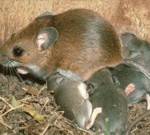by Alister Doyle
Better protection for the diversity of the planet's creatures and plants could help shield humans from diseases like AIDS, Ebola or bird flu and save billions of dollars in health care costs, researchers said on Tuesday. They said human disruptions to biodiversity – from roads through the Amazon jungle to deforestation in remote parts of Africa – had made people more exposed to new diseases that originate in wildlife.
"Biodiversity not only stores the promise of new medical treatments and cures, it buffers humans from organisms and agents that cause disease," scientists from the Diversitas international group said in a statement.
"Preventing emerging diseases through biodiversity conservation is far more cost effective than developing vaccines to combat them later," it said ahead of a November 9-10 conference of 700 biodiversity experts in Oaxaca, Mexico.
Peter Daszak, a scientist who helped find links between Asian bats and the SARS virus, said the 2003 outbreak of the flu-like disease cost about $50 billion, largely because it cut travel and trade from Asia. About 800 people died.
And AIDS, widely believed to have originated in chimpanzees, killed an estimated 3.1 million people in 2004 and the United Nations estimates that $15 billion will be needed for prevention, treatment and care in 2006 alone.
"Emerging diseases are causing a crisis of public health," Daszak, executive director of the consortium for conservation medicine at the Wildlife Trust, New York, told Reuters.
WILDLIFE TO PEOPLE
Diversitas experts urged governments to work out policies to protect biodiversity, including tougher regulations on trade, agriculture and travel to reduce chances that diseases like avian flu can jump from wildlife to people.
"We're not saying that we should lock up nature and throw away the key," said Charles Perrings, a biodiversity expert at Arizona State University. But he said humans should be more careful about disrupting areas of rich biodiversity.
He said diseases had spread from wildlife to humans throughout history but the risks were rising because of the impact of growing human populations on habitats.
The experts said the preservation of a wider range of species could also ease the impact of disease.
A factor helping the spread of Lyme disease in the eastern United States, for instance, was the absence of former predators like wolves or wild cats that once kept down numbers of white-footed mice – a reservoir of the infection.
Lyme disease was also less of a problem for humans in U.S. states where the ticks that transmit the disease had more potential targets, like lizards or small mammals.
"The value of services provided by nature and its diversity is under-appreciated until they stop," said Anne Larigauderie, executive director of Paris-based Diversitas, a non-government organization.
She said China had to employ people in some regions to pollinate apple orchards because the over-use of pesticides had killed off bees. "It maybe takes 10 people to do the work of two beehives," she told Reuters.
And the Australian gastric brooding frog had once been seen as key for anti-ulcer drugs because it bizarrely incubated its young in its stomach after shutting off digestive acids. It has since become extinct, taking its secrets with it.




